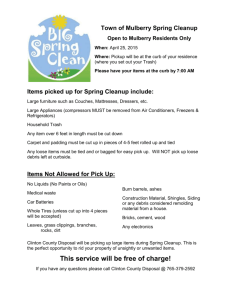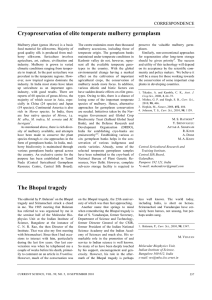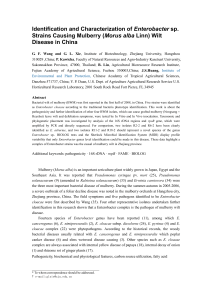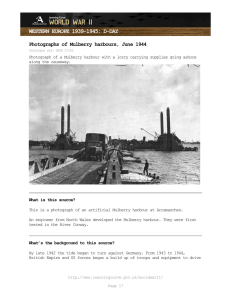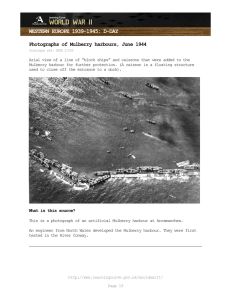Organic acids, sugars, vitamin C, antioxidant capacity, and phenolic
advertisement
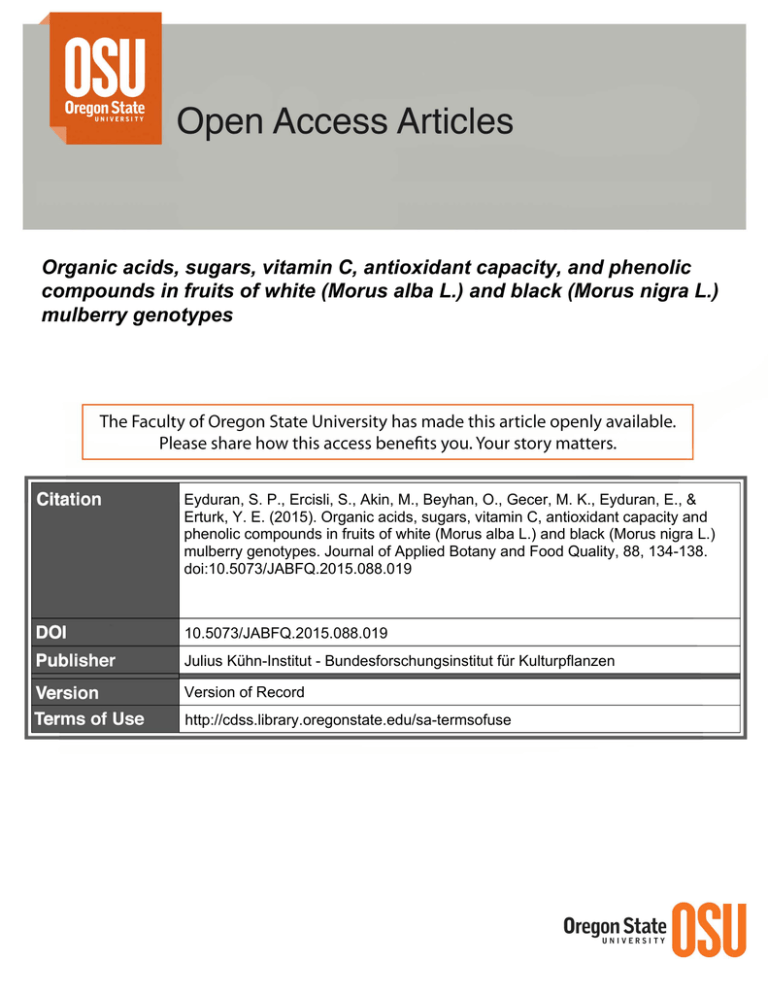
Organic acids, sugars, vitamin C, antioxidant capacity, and phenolic compounds in fruits of white (Morus alba L.) and black (Morus nigra L.) mulberry genotypes Eyduran, S. P., Ercisli, S., Akin, M., Beyhan, O., Gecer, M. K., Eyduran, E., & Erturk, Y. E. (2015). Organic acids, sugars, vitamin C, antioxidant capacity and phenolic compounds in fruits of white (Morus alba L.) and black (Morus nigra L.) mulberry genotypes. Journal of Applied Botany and Food Quality, 88, 134-138. doi:10.5073/JABFQ.2015.088.019 10.5073/JABFQ.2015.088.019 Julius Kühn-Institut - Bundesforschungsinstitut für Kulturpflanzen Version of Record http://cdss.library.oregonstate.edu/sa-termsofuse Journal of Applied Botany and Food Quality 88, 134 - 138 (2015), DOI:10.5073/JABFQ.2015.088.019 1 Igdir University, Agricultural Faculty, Department of Horticulture, Igdir-Turkey University, Agricultural Faculty, Department of Horticulture, Erzurum, Turkey 3 Oregon State University, Agricultural Faculty, Department of Horticulture, Corvallis, Oregon-USA 4Sakarya University, Pamukova Vocational School, Sakarya-Turkey 5 Igdir University, Agricultural Faculty, Department of Animal Science, Biometry Genetics Unit, Igdir-Turkey 6 Igdir University, Agricultural Faculty, Department of Agricultural Economy, Igdir-Turkey 2Ataturk Organic acids, sugars, vitamin C, antioxidant capacity, and phenolic compounds in fruits of white (Morus alba L.) and black (Morus nigra L.) mulberry genotypes S.P. Eyduran1, S. Ercisli2, M. Akin3, O. Beyhan4, M.K. Gecer1, E. Eyduran5, Y.E. Erturk6 (Received January 26, 2015) Summary Mulberries (Morus spp.) are historically grown in particular microclimatic regions in Eastern Anatolia, including Aras valley. In the valley, mulberries are one of the ancient crop and used for several purposes by local people. The aim of the present study was to first time evaluate organic acids, sugars, vitamin C, antioxidant capacity (TEAC assay, Trolox Equivalent Antioxidant Capacity). and phenolic compounds of the historical black and white mulberry genotypes growing in Aras valley in Turkey. Results showed that, species and geno-types strongly influenced the chemical content and antioxidant capa-city (p<0.05). Malic acid was the main organic acid in all genotypes and ranged from 1.130 to 3.040 g/100 g. Among sugars, fructose and glucose are predominant and were between 4.057 and 7.700 g/100 g and 5.337 and 9.437 g/100 g in all mulberry genotypes, respectively. The black mulberry genotypes showed remarkably higher antioxidant capacity determined by TEAC assay (10.167 to 14.400 μmol TE/g) compared to white mulberry genotypes (6.170 to 9.273 μmol TE/g). Chlorogenic acid and rutin were the main phenolic compounds. Introduction Mulberries are widely spread on tropical, subtropical and temperate zones of Asia, Europe, America, and Africa, which indicate their high adaptation capacity to different environmental conditions (ERCISLI and ORHAN, 2007). Turkey is one of the important diversity centers of mulberries with a long cultivation history dating back to 400500 years ago. The most popular mulberry species with edible fruits grown in Turkey are Morus nigra, Morus rubra, Morus alba and Morus laevigata (OZGEN et al., 2009; YILDIZ, 2013). The high genotypic diversity for mulberries in Turkey (KAFKAS et al., 2008) is especially attributed to its long period generative propagation in Turkey in the past. Although white mulberry (Morus alba) is the main cultivated specie in Turkey with share 95 % of the total production. More recently there is a growing interest on black and white mulberries and potential benefits on human health associated with its higher phytochemical content and antioxidant properties (ERCISLI and ORHAN, 2007; ERCISLI and ORHAN, 2008; KOYUNCU et al., 2014; NATIC et al., 2015; SANCHEZ et al., 2014; SANCHEZSALCEDO et al., 2015). Since ancient times, mulberry has been cultivated in some microclimatic areas particularly in eastern Anatolia including Aras valley. The plant is also widely grown in western Anatolia as well as Mediterranean side of Turkey. Each growing area has own special genotypes, which greatly differ each others (ERCISLI, 2004). Traditionally, mulberry fruits have been processing into several product including mulberry juice, molasses, jam, vinegar and some very special pro* Corresponding author ducts such as ‘mulberry pestil’, ‘mulberry kome’, etc. in Turkey. All of these products have significant marketing value due to its nutritive features and distinct aroma characteristics (ERTURK and GECER, 2012). There are big differences between black (Morus nigra) and white (Morus alba) mulberry trees and particularly fruits. Morus nigra is one of the most difficult fruit species for vegetative propagation and it has also slow growing characteristics. Plant habit of this species is more compact and free of pest of diseases due to thick leaves and high phenolic contents in its tissues (ERCISLI and ORHAN, 2008). Black mulberry fruits are mainly processed into juice and have also high fresh consumption value. Mulberry fruits are harvested several times in a growing period (four to seven times in a year, according to altitude of orchards). The first harvested fruits are sent to market for fresh consumption, while later harvested fruits have increased their sugar content during fruit development and are destined for processing purposes. Black and red mulberry fruits have been used in small quantities for jam industry (AKBULUT et al., 2006). In Turkey 95% of mulberry trees belongs to white mulberry (Morus alba) and 70% of white mulberry fruits processed into mulberry molasses, whereas 10% processed into ‘Mulberry kome’ and 3% processed into ‘Mulberry pestil’. Approximately 4% dried and 5% consumed as fresh of white mulberries (ERCISLI, 2004). The other species cannot be used to obtain above products. However, fruits of Morus nigra, are purple to black in color, juicy and with pleasant acidic flavor (ERCISLI and ORHAN, 2008; OZGEN et al., 2009). Together with fresh consumption, fruits of black mulberry are utilized in syrup, marmalade, ice-cream, vinegar and vine industries (GUNDOGDU et al., 2011). Fruits of Morus nigra are very rich source of phenolics due to their high content in anthocyanins (ARAMWIT et al., 2010). Phenolic compounds prove anti-aging properties attributed to their antioxidant activity by scavenging free radicals. In addition, many studies suggest that phenolics help reducing the risk of coronary heart diseases and some cancer types (RODRIGUEZ-MATEOS et al., 2014). Black mulberries are important for use in folk medicine as a remedy for diabetes, arthritis, hypertension, anemia and moth lesions due to its high phytochemical content (BAE and SUH, 2007; KOSTIC et al., 2013). Organic acids and sugars are another important components of the fruits, characterizing their organoleptic properties. The flavor, which is a very significant criterion in fresh market, is generally characterized by the ratio of organic acids and sugars. In addition, organic acids are probable antioxidants with multi-purpose usages in pharmacology (SOYER et al., 2003). Besides environmental conditions, genotype is a prominent factor in the determination of fruit chemical composition and antioxidant capacity (HEGEDUS et al., 2010; MIKULIC-PETKOVSEK et al., 2012; ROP et al., 2014; JURIKOVA et al., 2014). In the last decade, several Bioactive content of mulberries from Eastern Anatolia studies have been reported on the definition of the organic acids, sugars, and phenolic compounds of black, white, and red mulberries growing naturally at different part of Turkey for promoting quality of the produced products in mulberry industry (KOYUNCU, 2004; ERCISLI and ORHAN, 2008; OZGEN et al., 2009, GUNDOGDU et al., 2011; ORHAN and ERCISLI, 2014). To our knowledge, no available data are found on the definition of the phytochemical characteristics of mulberries grown in Aras valley-located eastern Anatolia in Turkey. Hence, the objective of this study was to investigate the organic acids, sugars, vitamin C, antioxidant capacity, and phenolic compounds of the historical Morus nigra (Black Mulberry) and Morus alba (White Mulberry) genotypes growing wildly in Melekli district of Igdir province in Turkey. The phytochemical definition of the reachable genotypes for proving a distinguishable improvement in mulberry industry will be a notable reference to similar further studies. Materials and methods Study area Eastern Anatolia Region is located in the easternmost part of Turkey. It is bounded by Turkey’s Central Anatolia Region on the west, its Black Sea Region on the north, its Southeast Anatolia Region and Iraq on the south, and with Iran, Azerbaijan, Armenia, and Georgia on the east. Since most of the region is far from the sea, and has high altitude, it has a long winter and short summer periods. During the winter, it is very cold and snowy, during summer the weather is cool in the highlands and warm in the lowlands. The region has the lowest average temperature of all Turkish regions (-25 °C) and sometimes temperature drop below -40 °C in winter. The summer average is about 20 °C. The region’s annual temperature difference is the highest in Turkey. However, some areas such as Igdir province in the region have milder climate and accepted as microclimate. Plant material Three black mulberry (Morus nigra ) genotypes (76-IGD-1, 76-IGD-2 and 76-IGD-3) and two white mulberry (Morus alba) genotypes (76IGD-4 and 76-IGD-5) were used as material. Mulberry trees found in Melekli district (latitude 39° 56' 47 N, longitude 44° 5' 52 E, and 856 meters above sea level) belong to Igdir province, located in Aras valley, eastern Anatolia region in Turkey. Fruits (berries) for analyses were collected from different branches of one mulberry plant (tree) per genotype because there was only one plant (tree) per genotype in natural growing area. In Turkey mulberry trees are generally found in natural growing areas and there were no similar genotypes. A total of 100 fruits (berries) were sampled per genotype to ensure good representative of the genotypes to make average sampling, and the berries of those mulberry genotypes were taken during commercial ripe stage. The berries were stored at -20 oC (OZGEN et al., 2009) until the extraction and analysis of organic acids, sugars, vitamin C, antioxidant capacity, and phenolic compounds. Analysis of organic acids Succinic, citric, malic, fumaric and tartaric acid composition of mulberries were analyzed by modified method of BEVILACQUA and CALIFANO (1989). Fruits were mashed within a cheesecloth and the obtained sample juices were stored at (-20 °C) until processed. 5 mL sample juice and 20 mL 0.009 N H2SO4 were mixed (Heidolph Silent Crusher M, Germany), and homogenized using a shaker (Heidolph Unimax 1010, Germany) for 1 hour, after which centrifuged for 15 min at 15000 rpm. Supernatants were firstly filtrated with coarse filter, then twice with 0.45 μm membrane filter (Millipore MillexHV Hydrophilic PVDF, Millipore, USA), and run through SEP-PAK C18 cartridge. HPLC device was adjusted to 214 and 280 nm wave- 135 lengths, on Agilent package program (Agilent, USA) with Aminex column (HPX - 87 H, 300 mm x 7.8 mm, Bio-Rad Laboratories, Richmond, CA, USA) was used for the determination of organic acids. The results are presented as g/100 g fresh mass. Extraction and determination of sugars Modified method of MELGAREJO et al. (2000) was used for sugar content determination. Samples of 5 mL were centrifuged at 12000 rpm for 2 min at 4 °C, than filtrated in SEP-PAK C18 column. μbondapakNH2 column with 85% acetonitrile liquid phase with refractive index detector (IR) was used for the HPLC device. Calculations of the sugar concentrations were according to the prepared fructose and glucose standards. The results are presented as g/100 g fresh mass. Analysis of ascorbic acid (Vitamin C) Ascorbic acid content was determined according to the method suggested by CEMEROGLU (2007). Samples of 5 mL were mixed with % 2.5 (w/v) metaphosphoric acid (Sigma, M6285, 33.5%), and centrifuged at 6500 rpm for 10 min at 4 °C. 0.5 mL of the solution was completed to 10 mL with % 2.5 (w/v) metaphosphoric acid. Supernatants were passed through 0.45 μm membrane filter. Ascorbic acid detection was made with HPLC device using C18 column (Phenomenex Luna C18, 250 x 4.60 mm, 5 μ) and the temperature was adjusted to 25 °C. Mobile phase consisted of ultra distilled water with 1 mL/min flow rate at 2.2 pH acidified with H2SO4. DAD detector was used and spectral measurements were made at 254 nm wavelength. Different levels of L-ascorbic acid (SigmaA5960) (50, 100, 500, 1000, and 2000 ppm) were used for ascorbic acid readings. Results are presented as mg/100 g fresh mass. Determination of Trolox Equivalent Antioxidant Capacity (TEAC) Trolox equivalent antioxidant capacity (TEAC) analysis was performed with ABTS formulated with potassium persulphate dissolved in a buffer (OZGEN et al., 2006). For longer stability, ABTS+ was diluted with 20 mM sodium acetate buffer with pH 4.5, at 734 nm wavelength, 0.700 ± 0.01. Spectrometric assay was done by mixing 20 μL of the samples with 3 ml ABTS+ for 10 min, and absorbance measurements were done at 734 nm wavelength. The results are presented as μmol TE/g fresh mass. Analysis of phenolic compounds Phenolic compounds viz. gallic acid, catechin, chlorogenic acid, caffeic acid, p-coumaric acid, o-coumaric acid, ferulic acid, vanillic acid, rutin, syringic acid, and quercetin were analyzed with the modified method of RODRIGUEZ-DELGADO et al. (2001). Fruit juice samples were mixed in a ratio of 1:1 with distilled water and centrifuged for 15 min at 15000 rpm. After filtration with coarse filter paper and twice with 0.45 μm membrane filter (Millipore Millex-HV Hydrophilic PVDF, Millipore, USA), the supernatants were injected to HPLC. Agilent 1100 (Agilent) HPLC system on a DAD dedector (Agilent. USA) was used. Chromatographic separation was performed with 250 x 4.6 mm, 4 μm ODS column (HiChrom, USA). As a mobile phase, Solvent A methanol:acetic acid:water (10:2:28) and Solvent B methanol:acetic acid:water (90:2:8) with flow rate 1 mL/ min and 20 μL injection volume were used for spectral measurements at 254 and 280 nm. Results are presented as mg/g fresh mass. Statistical analysis Five replicates including 20 fruits per replicate were used. Descriptive statistics of organic acids, sugars, vitamin C, antioxidant capacity, and phenolic compounds extracted from 2 Morus alba and 3 Morus 136 S.P. Eyduran, S. Ercisli, M. Akin, O. Beyhan, M.K. Gecer, E. Eyduran, Y.E. Erturk nigra genotypes were represented as Mean ± SE. The phytochemical characteristics were statistically analyzed with One-way ANOVA with five replicates. Duncan Test determined significant differences between the evaluated genotypes. All statistical evaluations were performed using SPSS 20. and elimination of kidney stones (PENNISTON et al., 2007). Malic acid possesses many health related benefits such as boosting immunity, maintaining oral health, reducing the risk of poisoning from a build-up of toxic metals, promoting smoother and firmer skin and help reducing symptom of fibromyalgia (ABRAHAM and FLECHAS, 1992). Results and Discussion Sugars Main sugars as glucose and fructose contents of mulberry samples were also investigated. We found higher glucose content than fructose in fruits of all mulberry genotypes. The genotype ‘76-IGD-4’ (white mulberry) had the highest glucose (9.437 g/100 g) and fructose (7.700 g/100 g) content (Tab. 2). The lowest glucose (5.337 g/ 100 g) and fructose content (4.057 g/100 g) was determined in ‘76IGD-5’ (white mulberry) genotype (Tab. 2). The glucose contents of the genotypes were in descending order ‘76-IGD-4’ (white mulberry) > ‘76-IGD-3’ (black mulberry) > ‘76-IGD-2’ (black mulberry) = ‘76IGD-1’ (black mulberry) > ‘76-IGD-5’ (white mulberry). However this order was ‘76-IGD-4’ (white mulberry) > ‘76-IGD-3’ (black mulberry) > ‘76-IGD-1’ (black mulberry) > ‘76-IGD-2’ (black mulberry) = ‘76-IGD-5’ (white mulberry) for fructose content (Tab. 2). The ratio of glucose/fructose were 1.500 in ‘76-IGD-2’ (black mulberry) > 1.311 in ‘76-IGD-5’ (white mulberry) > 1.225 in ‘76-IGD-4’ (white mulberry) > 1.196 in ‘76-IGD-3’ (black mulberry) > 1.098 in ‘76-IGD-1’ (black mulberry) (Tab. 2). SANCHEZ et al. (2014) re��� ported that the predominant sugar was fructose (~61%) followed by glucose (~39%), while sucrose was presented only at trace level in mulberry fruits sampled from Spain and they also found big genotypic differences among clones for different sugars. OZGEN et al. (2009) declared that fructose and glucose contents of 14 black and red mulberry genotypes ranged from 4.86 to 6.41 g/100 mL, and 5.50 to 7.12 g/100 mL, respectively. In a more comprehensive study, MIKULIC-PETKOVSEK et al. (2012) suggested that fructose and glucose were predominant sugars for 25 wild or cultivated berry species and they reported that glucose and fructose contents were found 3.68 Tab. 1 shows the results of organic acids, Tab. 2 shows sugars, vitamin C and antioxidant capacity and Tab. 3 shows phenolic compounds of 2 white and 3 black mulberry genotypes collected from Melekli district in Igdir province. ANOVA indicated that the genotype had a major influence on all parameters under evaluation (p<0.05). Organic acids As shown in Tab. 1, among organic acids, malic acid was the predominant one for all the mulberry genotypes in the study. It was followed by citric acid, succinic acid, tartaric acid, and fumaric acid, respectively. The malic acid levels in fruits were between 1.130 (‘76IGD-5’, white mulberry) and 3.040 g/100 g (‘76-IGD-3’, black mulberry). Black mulberries had the highest level in citric acid (1.033 mg/L) compared to white mulberries (Tab. 1). SANCHEZ et al. (2014) from Spain and OZGEN et al. (2009) and GUNDOGDU et al. (2011) from Turkey reported that malic and citric acids were main organic acids in mulberry fruits. The results indicated that the fumaric acid contents were detected at the lowest values for all black and white mulberry genotypes. KOYUNCU (2004) and MIKULIC-PETKOVSEK et al. (2012) found that fumaric acid was found to be lowest level among the organic acids in black mulberry fruits. The organic acids contained in fruits are one of the important factors influencing fruit flavor and are of vital importance to human health. Several studies emphasized the importance of organic acids such as malic, citric and tartaric acids which are important in prevention Tab. 1: Organic acids (g/100 g FW) content of black and white mulberry genotypes Genotypes Citric acid Tartaric acid Malic acid 76-IGD-1 (Black) 0.877±0.018b 0.147±0.007d 76-IGD-2 (Black) 0.733±0.009c 0.223±0.015c 76-IGD-3 (Black) 1.033±0.032a 76-IGD-4 (White) 0.687±0.022c 76-IGD-5 (White) CV % Succinic acid Fumaric acid 1.210 ±0.015d 0.280±0.015c 0.010± 0.000d 2.713±0.048b 0.360±0.006b 0.057±0.012c 0.297±0.017b 3.040±0.056a 0.117±0.007d 0.107±0.003ab 0.153±0.009d 2.103±0.028c 0.267±0.009c 0.100±0.006b 0.480±0.021d 0.430±0.006a 1.130±0.023d 0.437±0.012a 0.123±0.003a 4.9 7.9 3.2 6.1 13.8 Means with different letter in same column were statistically significant (p<0.05). Tab. 2: Sugar (g/100 g FW), vitamin C (mg/100 g FW) and antioxidant capacity (μmol TE/g FW) of black and white mulberry genotypes Genotypes Glucose Fructose TEAC Vitamin C 76-IGD-1 (Black) 6.173±0.052c 5.620±0.071c 11.297±0.047b 10.123±0.023e 76-IGD-2 (Black) 6.247 ±0.088c 4.163 ±0.035d 14.400±0.025a 16.293± 0.039b 76-IGD-3 (Black) 8.573±0.061b 7.167±0.037b 10.167±0.043c 12.040±0.055d 76-IGD-4 (White) 9.437±0.048a 7.700±0.070a 6.170±0.061e 18.220±0.136a 76-IGD-5 (White) 5.337±0.075d 4.057±0.052d 9.273±0.038d 13.400±0.081c 1.6 1.7 0.8 1.00 CV % Means with different letter in same column were statistically significant (p<0.05). Bioactive content of mulberries from Eastern Anatolia and 3.99 g/100 g for black mulberry grown naturally in central Slovenia, and that the concentration of fructose sweeter than glucose or sucrose was important for consumers willing sweeter fruit. The present genotypes illustrated wide variability for the sugars, which may be ascribed to genetic factors, cultural applications, and ecological conditions (light, temperature, and humidity etc.) as also referred in the previous studies (GUNDOGDU et al., 2011). 137 acid, ferulic acid, o-coumaric acid, vanillic acid, rutin and quercetin in mulberry fruits were 0.150, 0.075, 3.106, 0.131, 0.103, 0.129, 0.064, 0.134, 0.036, 1.423, and 0.113 mg/g for black mulberries, and 0.215, 0.037, 0.119, 0.133, 0.049, 0.047, 0.033, 0.015, 0.008, 1.111, and 0.015 mg/g for white mulberries, respectively. MEMON et al. (2010) used white mulberry fruits in three extraction techniques (sonication, magnetic stirring, and homogenization) and found that gallic acid (5.81, 4.32, and 3.57 mg/100 g), vanillic acid (4.57, 3.95, and 3.70 mg/100 g), chlorogenic acid (20.47, 17.03, and 24.45 mg/ 100 g) and syringic acid (9.19, 6.31 and 8.48 mg/100 g) were main phenolic compounds in the fruits of Morus alba (white mulberry). For the fruits of Morus nigra (black mulberry), these values were 5.81, 1.72, and 4.21 mg/100 g for gallic acid, 2.31, 2.25, and 1.63 mg/ 100 g for vanillic acid, 4.41, 5.43, and 7.44 mg/100 g for chlorogenic acid, 1.81, 1.63 and 1.59 mg/100 g for syringic acid and 8.66, 2.27 and 4.89 for p-coumaric acid. The difference may be ascribed to the use of different extraction methods. GUNDOGDU et al. (2011) argued that, within the phenolic compounds, chlorogenic acid had the highest content for black mulberry (Morus nigra), which was in agreement with the first two black mulberry genotypes, but not consistent with the predominant content (rutin) for the last black mulberry accession (Tab. 1). Conversely, in the present study, chlorogenic acid was also determined to be the predominant phenolic compound for two white mulberry genotypes. The difference may be due to genetic factors, and non-genetic factors (temperature, humidity, light, etc.), and cultural applications (HEGEDUS et al., 2008; GUNDOGDU et al., 2011). Vitamin C and antioxidant capacity We found vitamin C content between 10.123 and 16.293 mg/100 g for black mulberry genotypes under the investigation (Tab. 2). In the earlier work conducted on the northeast Anatolia region of Turkey, ERCISLI and ORHAN (2008) reported vitamin C contents of black mulberry genotypes varied from 14.9 to 18.8 mg/100 mL. ERCISLI et al., (2010) reported the average vitamin C content in black and purple mulberries as 20.79 and 18.87 mg per 100 mL, respectively. Fruit species can be classified into three groups (low, moderate and high) in terms of their vitamin C content (KARACALI, 2000) and mulberries are generally placed within the moderate vitamin C content group. LALE and OZCAGIRAN (1996) reported that vitamin C content in black and purple mulberries was 16.6 and 11.9 mg/100 mL. Results of statistical assessments made for antioxidant activity (TEAC assay) are presented in Tab. 2. As depicted in Tab. 2, the analysis results of variance illustrated that the genotype is of big importance in characterizing TEAC (P<0.05) that changed between 6.170 and 14.400 μmol TE/g FW and black mulberries had higher than white mulberries. The highest contents for TEAC were statistically enabled by ‘76-IGD-2’, followed by ‘76-IGD-1’ > ‘76-IGD-3’ > ‘76-IGD-5’ > ‘76-IGD-4’ (Tab. 2). GUNDOGDU et al. (2011) reported that black mulberry had highest TEAC values than white mulberry. Conclusion We have characterized for the first time the chemical attributes of white and black mulberry genotypes from Igdir province located Eastern Anatolia in Turkey. Organic acids, sugars, vitamin C, antioxidant activity, and phenolic spectrum varied significantly within and between white and black mulberry genotypes. High antioxidant activity was found in particular in black mulberry genotypes. The study highlighted that the chemical properties of mulberry fruits (berry) were strongly affected by genotype. This study also increases our knowledge about variation of phytochemical properties including organic acids, sugars, vitamin C, antioxidant activity and phenolic spectrum in mulberry fruits and may be useful to producers, breeders and processors. Phenolic compounds In our study, we found different levels of gallic acid, catechin, chlorogenic acid, caffeic acid, syringic acid, p-coumaric acid, ferulic acid, o-coumaric acid, vanillic acid, rutin, and quercetin in fruits of black and white mulberry genotypes (Tab. 3). Chlorgenic acid and rutin were the main phenolics for mulberry fruits. Our results are consistent with the findings of GUNDOGDU et al. (2011) and NATIC et al. (2015). GUNDOGDU et al. (2011) reported that the amount of gallic acid, catechin, chlorogenic acid, caffeic acid, syringic acid, p-coumaric Tab. 3: Phenolic compounds (mg/g FW) of black and white mulberry genotypes 76-IGD-1 (Black) 76-IGD-2 (Black) 76-IGD-3 (Black) 76-IGD-4 (White) 76-IGD-5 (White) CV% Catechin 0.085±0.002a 0.046±0.002c 0.066±0.001b 0.032±0.002d 0.070±0.002b 5.0 Rutin 0.820±0.004b 1.365±0.198a 1.238±0.004a 0.750±0.002b 0.925±0.004b 15.0 Quercetin 0.119±0.002b 0.067±0.001d 0.137±0.003a 0.101±0.003c 0.045±0.001e 4.2 2.339±0.004b 1.641±0.004c 0.759±0.005e 2.667±0.004a 0.980±0.005d 0.4 Chlorogenic Acid Ferulic acid 0.036±0.002d 0.023±0.001e 0.063±0.002c 0.110±0.003b 0.141±0.003a 5.2 o-coumaric acid 0.034±0.001d 0.129±0.003a 0.043±0.001c 0.062±0.002b 0.026±0.001e 5.3 p-coumaric acid 0.111±0.004b 0.062±0.002c 0.035±0.001d 0.065±0.002c 0.127±0.003a 5.9 Caffeic acid 0.114±0.002c 0.094±0.002d 0.158±0.004a 0.094±0.003d 0.134±0.001b 3.7 Syringic acid 0.119±0.001a 0.053±0.001d 0.085±0.002b 0.115±0.004a 0.060±0.001c 4.3 Vanillic acid 0.035±0.001c 0.011±0.001e 0.062±0.002b 0.074±0.002a 0.017±0.001d 6.5 Gallic acid 0.122±0.003b 0.410±0.004a 0.105±0.003b 0.206±0.004b 0.214±0.083b 30.5 Means with different letter in same row were statistically significant (p<0.05). 138 S.P. Eyduran, S. Ercisli, M. Akin, O. Beyhan, M.K. Gecer, E. Eyduran, Y.E. Erturk References ABRAHAM, G., FLECHAS, J., 1992: Management of fibromyalgia: rationale for the use of magnesium and malic acid. J. Nutr. Med. 3, 49-59. AKBULUT, M., CETIN, C., COKLAR, H., 2006: Determination of chemical content and minerals in mulberry cultivars. Proceedings of 2nd National Berry Symposium, 14-16 September 2006, Tokat-Turkey, 176-180. ARAMWIT, P., BANG, N., SRICHANA, T., 2010: The properties and stability of anthocyanins in mulberry fruits. Food Res. Int. 43, 1093-1097. BAE, S., SUH, H.-J., 2007: Antioxidant activities of five different mulberry cultivars in Korea. LWT. 40, 955-962. BEVILACQUA, A.E., CALIFANO, A.N., 1989: Determination of organic acids in dairy products by high performance liquid chromatography. J. Food Sci. 54, 1076-1079. CEMEROGLU, B., 2007: Food Analysis. Publication of Food Technology Society, 168-171, No: 34, Ankara, Turkey. ERCISLI, S., 2004: A short review of the fruit germplasm resources of Turkey. Genet. Res. Crop Evol. 51, 419-435. ERCISLI, S., ORHAN, E., 2007: Chemical composition of white (Morus alba), red (Morus rubra) and black (Morus nigra) mulberry fruits. Food Chem. 103, 1380-1384. ERCISLI, S., ORHAN, E., 2008: Some physico-chemical characteristics of black mulberry (Morus nigra L.) genotypes from Northeast Anatolia region of Turkey. Sci. Hortic. 116, 41-46. ERCISLI, S., TOSUN, M., DURALIJA, B., VOCA, S., SENGUL, M., TURAN, M., 2010: Phytochemical content of some black (Morus nigra L.) and purple (Morus rubra L.) mulberry genotypes. Food Tecnol. Biotecnol. 48, 102106. ERTURK, Y.E., GECER, M.K., 2012: Economy of berries. Proceedings of 4th National Berry Symposium, 3-5 October 2012, Antalya-Turkey, 368385. GUNDOGDU, M., MURADOGLU, F., SENSOY, R.I.G., YILMAZ, H., 2011: Determination of fruit chemical properties of Morus nigra L., Morus alba L. and Morus rubra L. by HPLC. Sci. Hortic. 132, 37-41. HEGEDUS, A., BALOGH, E., ENGEL, R., SIPOS, B.Z., PAPP, J., BLAZOVICS, A., STEFANOVITS-BANYAI, E., 2008: Comparative nutrient element and antioxidant characterization of berry fruit species and cultivars grown in Hungary. Hort. Sci. 43, 1711-1715. HEGEDUS, A., ENGEL, R., ABRANKÓ, L., BALOGH, E., BLÁZOVICS, A., HERMÁN, R., HALÁSZ, J., ERCISLI, S., PEDRYC, A., STEFANOVITS-BÁNYAI, É., 2010: Antioxidant and antiradical capacities in apricot (Prunus armeniaca L.) fruits: Variations from genotypes, years, and analytical methods. J. Food Sci. 75, 722-730. JURIKOVA, T., SOCHOR, J., MLCEK, J., BALLA, S., KLEJDUS, B., BARON, M., ERCISLI, S., YILMAZ, S.O., 2014: Polyphenolic profile of interspecific crosses of rowan (Sorbus aucuparia L.). Ital. J. Food Sci. 26 (3), 317325. KAFKAS, S., OZGEN, M., DOGAN, Y., OZCAN, B., ERCISLI, S., SERCE, S., 2008: Molecular characterization of mulberry accessions in Turkey by AFLP markers. J. Am. Soc. Hort. Sci. 133, 593-597. KARACALI, I., 2000: The Storage and Handling of Horticultural Crops, Ege University, Agricultural Faculty, Turkey (in Turkish). KOSTIC, D.A., DIMITRIJEVIC, D.S., MITIC, S.S., MITIC, M.N., STOJANOVIC, G.S., ZIVANOVIC, A., 2013: Phenolic content and antioxidant activities of fruit extracts of Morus nigra L. (Moraceae) from Southeast Serbia. Trop. J. Pharm. Res. 12 (1), 105-110. KOYUNCU, F., 2004: Organic acid composition of native black mulberry fruit. Chem. Nat. Compd. 40 (4), 367-368. KOYUNCU, F., CETINBAS, M., IBRAHIM, E., 2014: Nutritional constituents of wild-grown black mulberry (Morus nigra L.). J. Appl. Bot. Food Qual. 87, 93-96. LALE, H., OZCAGIRAN, R., 1996: A study on pomological, phenological and fruit quality characteristics of mulberry (Morus sp.) species, Derim. 13, 177-182 (in Turkish). MELGAREJO, P., SALAZAR, D.M., ARTES, F., 2000: Organic acids and sugars composition of harvested pomegranate fruits. Eur. Food Res. Technol. 211, 185-190. MIKULIC-PETKOVSEK, M., SCHMITZER, V., SLATNAR, A., STAMPAR, F., VEBERIC, R., 2012: Composition of sugars, organic acids, and total phenolics in 25 wild or cultivated berry species. J. Food Sci. 77(10), 10641070. MEMON, A.A., MEMON, N., LUTHRIA, D.L., BHANGER, M.I., PITAFI, A.A., 2010: Phenolic acids profiling and antioxidant potential of mulberry (Morus laevigata W., Morus nigra L., Morus alba L.) leaves and fruits grown in Pakistan. Pol. J. Food Nutr. Sci. 60 (1), 25-32. NATIC, M.M., DABIC, D.C., PAPETTI, A., FOTIRIC-AKSIC, M.M., OGNJANOV, V., LJUBOJEVIC, M., TESIC, Z.Lj., 2015: Analysis and characterisation of phytochemicals in mulberry (Morus alba L.) fruits grown in Vojvodina, North Serbia. Food Chem. 171, 128-136. ORHAN, E., ERCISLI, S., 2014: Genetic relationships between selected Turkish mulberry genotypes (Morus spp.) based on RAPD markers. Gen. Mol. Res. 9 (4), 2176-2183. OZGEN, M., REESE, R.N., TULIO, A.Z., SCHEERENS, J.C., MILLER, A.R., 2006: Modified 2,2-Azino-bis-3-ethylbenzothiazoline-6-sulfonic Acid (ABTS) method to measure antioxidant capacitiy of selected small fruits and a comparison to Ferric Reducing Antioxidant Power (FRAP) and 2,2-Diphenyl-1-picrylhdrazyl (DPPH) methods. J. Agric. Food Chem. 54, 11511157. OZGEN, M., SERCE, S., KAYA, C., 2009: Phytochemical and antioxidant properties of anthocyanin-rich Morus nigra and Morus rubra fruits. Sci. Hortic. 119, 275-279. PENNISTON, K.L., STEELE, T.H., NAKADA, S.Y., 2007: Lemonade therapy increases urinary citrate and urine volumes in recurrent calcium oxalate stone formers. Urology 70 (5), 856-860. ROP, O., ERCISLI, S., MLCEK, J., JURIKOVA, T., HOZA, I., 2014: Antioxidant and radical scavenging activities in fruits of 6 sea buckthorn (Hippophae rhamnoides L.) cultivars. Turk. J. Agric. For. 38, 224-232. RODRIGUEZ-DELGADO, M.A., MALOVANA, S., PEREZ, J.P., BORGES, T., GARCIA-MONTELONGO, F.J., 2001: Separation of phenolic compounds by high-performance liquid chromatography with absorbance and fluorimetric detection. J. Chroma. 912, 249-257. RODRIGUEZ-MATEOS, A., VAUZOUR, D., KRUEGER, C.G., SHANMUGANAYAGAM, D., REED, J., CALANI, L., MENA, P., DEL RIO, D., CROZIER, A., 2014: Bioavailability, bioactivity and impact on health of dietary flavonoids and related compounds: an update. Arch Toxicol. 88, 1803-1853. SANCHEZ, E.M., CALIN-SANCHEZ, A., CARBONELL-BARRACHINA, A.A., MELGAREJO, P., HERNANDEZ, F., MARTINEZ-NICOLAS, J.J., 2014: Physicochemical characterization of eight Spanish mulberry clones: Processing and fresh market aptitudes. Int. J. Food Sci. Technol. 49, 477-483. SANCHEZ-SALCEDO, E.M., MENA, P., GARCIA-VIGUERA, C., MARTINEZ, J.J., HERNANDEZ, F., 2015: Phytochemical evaluation of white (Morus alba L.) and black (Morus nigra L.) mulberry fruits, a starting point for the assessment of their beneficial properties. J. Funct. Foods 12, 399-408. SOYER, Y., KOCA, N., KARADENIZ, F., 2003: Organic acid profile of Turkish white grapes and grape juices. J. Food Comp. Anal. 16, 629-636. YILDIZ, O., 2013: Physicochemical and sensory properties of mulberry products: Gümüşhane pestil and köme. Turk. J. Agric. For. 37, 762-771. Address of the corresponding author: E-mail: sercisli@gmail.com © The Author(s) 2015. This is an Open Access article distributed under the terms of the Creative Commons Attribution Share-Alike License (http://creativecommons.org/licenses/by-sa/4.0/).

